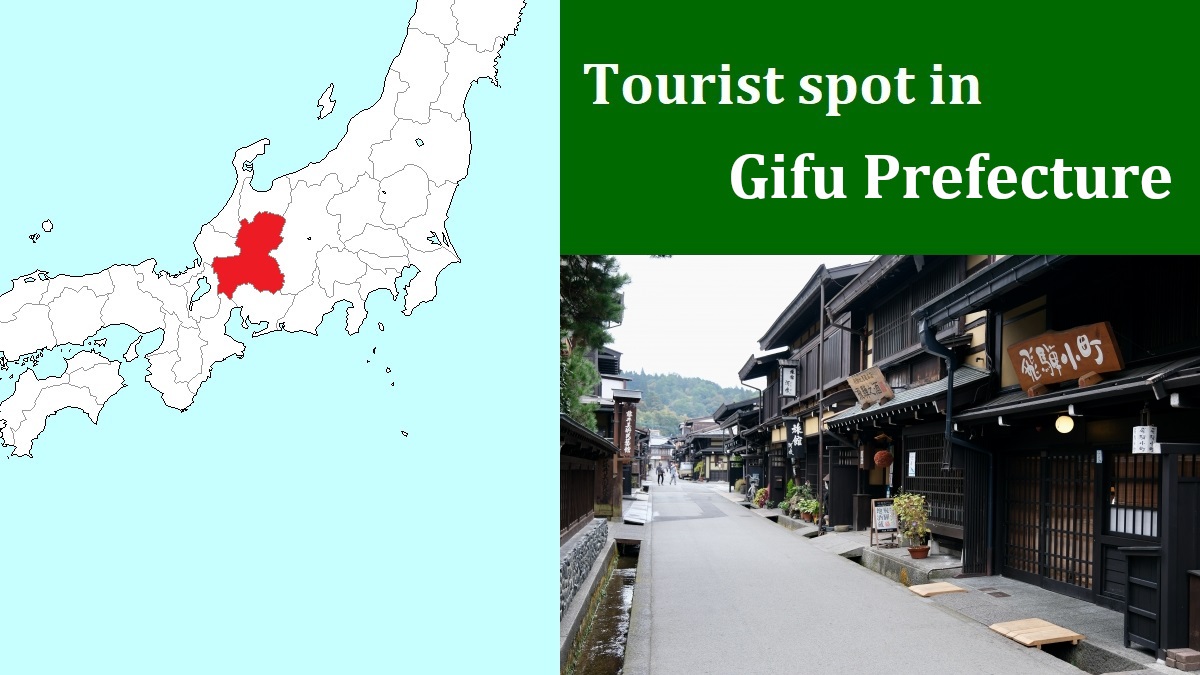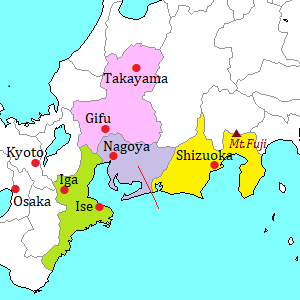Gifu city [岐阜]
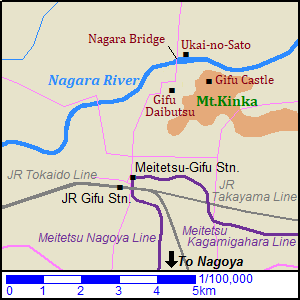
Gifu city is the prefectural capital of Gifu Prefecture.
It is located nearly at the south edge of Gifu Prefecture and about 30 km north-northwest of Nagoya city.
Nagara River (長良川, "Nagaragawa" in Japanese) flows through the city from northeast to southwest.
The river is known as one of clear rivers in Japan, and the water flowing through Gifu city is also clear.
Nagaragawa Promenade is set up along the river, and many people play on the riverside in summer.
Gifu Castle (岐阜城)
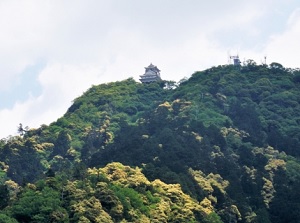
Gifu Castle on Mount Kinka
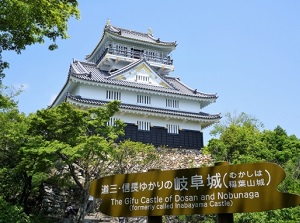
Gifu Castle
Gifu Castle is a castle located about 3.5 km northeast of Gifu station.
The castle is on the top of Mount Kinka (金華山, Kinkazan in Japanese, 329 m) rising by Nagara River.
The first castle was built in 1201.
From 15th to the 16th century, this castle had been involved in the power struggle by the warlords around this area, and the lords of the castle changed frequently.
After the foundation of Edo Government, Tokugawa Ieyasu, the Shogun, demolished this castle in 1601.
Therefore, the detail of the castle tower is not known.
The castle tower was restored as a historic construction in 1910.
But 1943, the castle had been destroyed by fire.
After that, current castle was rebuilt referencing ancient documents and drawings in 1956.
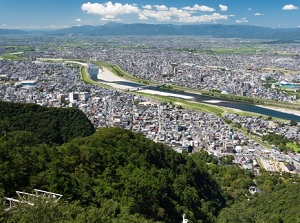
View from Gifu Castle
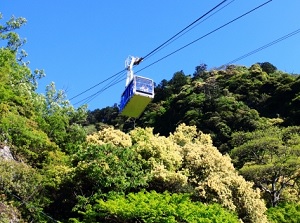
Kinkazan Ropeway
It has four floors and the inside is a museum.
The fourth floor is an observatory room.
To the castle, we can reach by Kinkazan Ropeway from the western foot of Mount Kinka.
The distance from the station on the top to the castle is about 250 meters.
Near the station, there is a tourist facility Squirrel Village that visitor can meet many squirrels living in Mount Kinka.
Gifu Park (岐阜公園)
The area along the western foot of Mount Kinka is Gifu Park.
It is about 500 meters from north to south and the width is about 100 meters.
There is the station of ropeway to Gifu Castle.
And, there are some museums, Japanese garden and various facilities.
Gifu Daibutsu (岐阜大仏)
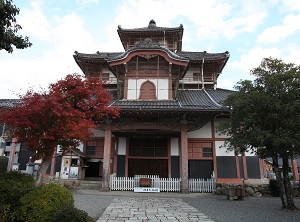
Daibutsuden in Shoboji
Photo by Gifu City
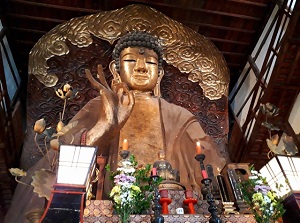
Gifu Daibutsu
Gifu Daibutsu is a great Buddha statue in Shôbôji temple located just southwest of Gifu Park.
Shôbôji (正法寺) is a Buddhist temple founded in 1638 and the Daibutsu is the principle image of this temple.
This Daibutsu was created from 1791 to 1832.
The height is 13.6 meters, but this statue is not made of metal.
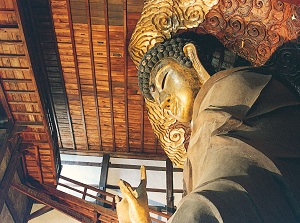
Gifu Daibutsu
Photo by Gifu City
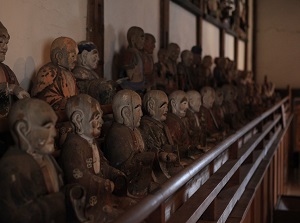
Small statues in Shoboji
Photo by Gifu City
The skeleton was made of woods, then the shape of the statue was formed by bamboos.
On the shape, a lot of Mino-washi papers with Buddhist scriptures written on them were coated.
Then, it was covered with many gold leaves after lacquering.
The priests at that time collected a large quantity of papers with Buddhist scriptures to create the statue with difficulty.
Therefore, it took 38 years to complete the statue.
Nagara River Ukai (長良川鵜飼)
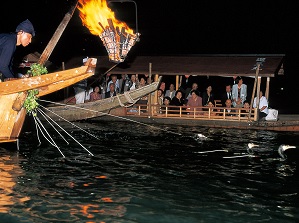
Nagara River Ukai
Photo by Gifu City
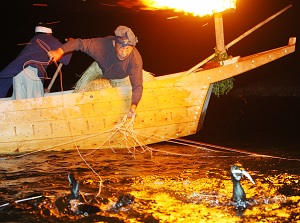
Nagara River Ukai
Photo by Gifu City
Ukai is an old fishing method to catch the river fishes using cormorants.
This Ukai has been done in Nagara River since the 8th century.
Kiso River Ukai in Inuyama city is also known, and it was started by the order of the lord of Inuyama Castle.
But, Nagara River Ukai was started by the order of Shogun of Edo Government.
Now, Ukai fishing for the Emperor is done several times a year, and the fishes are dedicated to the Emperor.
The performance for tourist is seen as a show on the boat.
It is performed from the middle of May to the middle of October.
It takes about 1.5 hours in common evening tour.
And it takes about 2 hours in the tours with meals.
The boarding point is at the foot of Nagara Bridge to the northwest of Gifu Park.
Ukai-no-Sato (鵜飼の里)
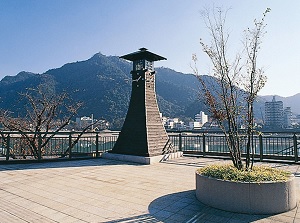
Nagaragawa Promenade
Photo by Gifu City
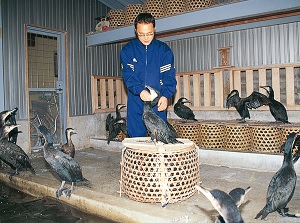
Birdhouse in fisherman's house
Photo by Gifu City
Ukai-no-Sato is the riverside area where the Ukai fishermen are living.
It is located on the opposite side of Mount Kinka across Nagara River.
Nagaragawa Promenade is set up in this area.
There are several Ukai fisherman's houses in the town.
But, they are not the sightseeing spots but normal houses.
In each yard, perhaps, there is a birdhouse for cormorants, and the equipment for Ukai fishing are put.
When you walk in the town, you may find such houses.
If you find a fisherman fortunately, he may show the house to you.
How to get here
By local train or rapid train of JR Tokaido Line, about 18 to 26 minutes from Nagoya to Gifu.
Or, by limited express on Meitetsu railway, anout 28 to 32 minutes from Meitetsu-Nagoya to Meitetsu-Gifu.
From Gifu or Meitetsu-Gifu station, by route bus, about 15 minutes to Gifu-koen stop (Gifu Castle, Gifu Park, Gifu Daibutsu).
About 16 minutes to Nagara-bashi stop (Ukai seeing).
About 17 minutes to Ukaiya stop (Ukai-no-Sato).

